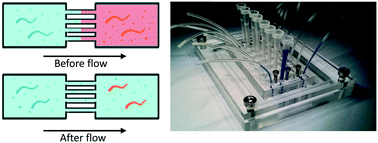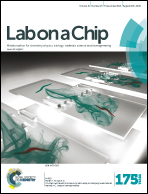On-chip microfluidic biocommunication assay for studying male-induced demise in C. elegans hermaphrodites†
Abstract
Like other animals, C. elegans nematodes have the ability to socially interact and to communicate through exchange and sensing of small soluble signaling compounds that help them cope with complex environmental conditions. For the time being, worm biocommunication assays are being performed mainly on agar plates; however, microfluidic assays may provide significant advantages compared to traditional methods, such as control of signaling molecule concentrations and gradients or confinement of distinct worm populations in different microcompartments. Here, we propose a microfluidic device for studying signaling via diffusive secreted compounds between two specific C. elegans populations over prolonged durations. In particular, we designed a microfluidic assay to investigate the biological process of male-induced demise, i.e. lifespan shortening and accelerated age-related phenotype alterations, in C. elegans hermaphrodites in the presence of a physically separated male population. For this purpose, male and hermaphrodite worm populations were confined in adjacent microchambers on the chip, whereas molecules secreted by males could be exchanged between both populations by periodically activating the controlled fluidic transfer of μl-volume aliquots of male-conditioned medium. For male-conditioned hermaphrodites, we observed a reduction of 4 days in mean lifespan compared to the non-conditioned on-chip culture. We also observed an enhanced muscle decline, as expressed by a faster decrease in the thrashing frequency and the appearance of vacuolar-like structures indicative of accelerated aging. The chip was placed in an incubator at 20 °C for accurate control of the lifespan assay conditions. An on-demand bacteria feeding protocol was applied, and the worms were observed during long-term on-chip culture over the whole worm lifespan.



 Please wait while we load your content...
Please wait while we load your content...